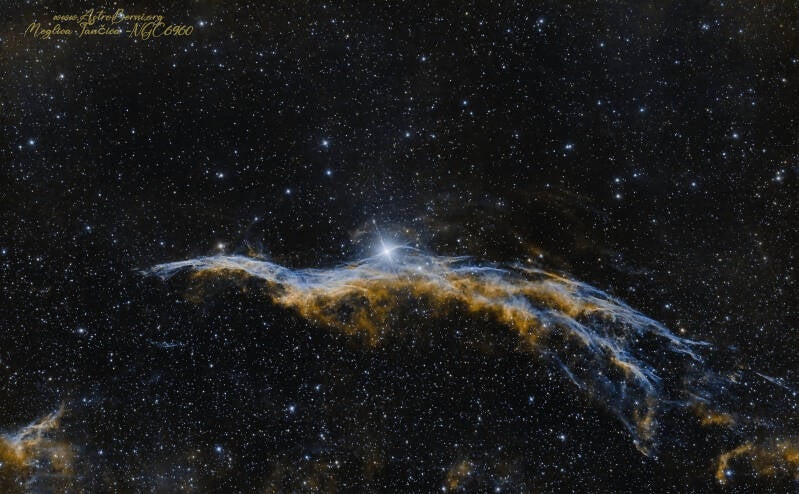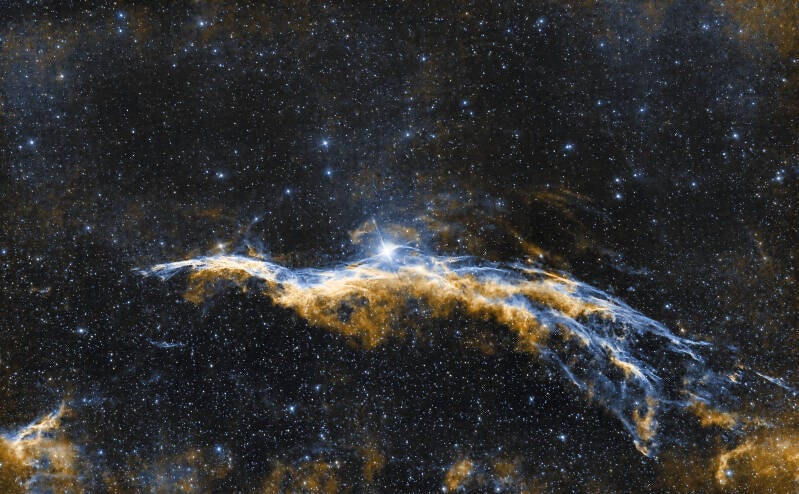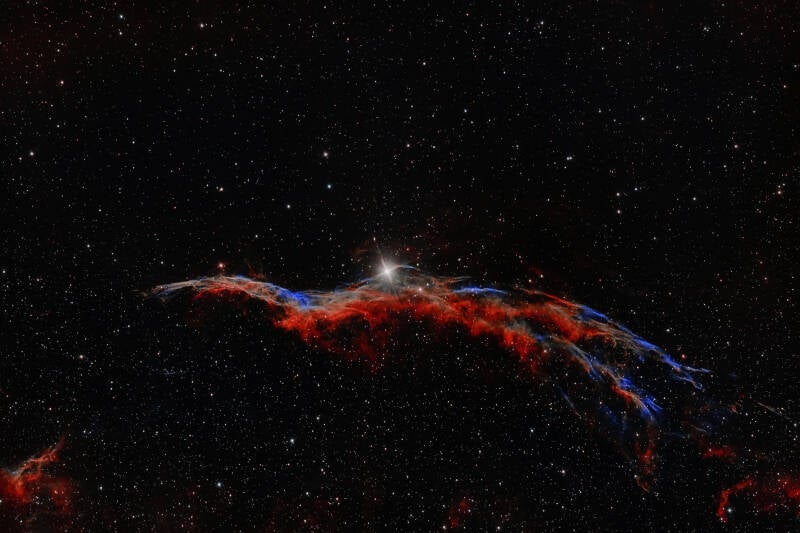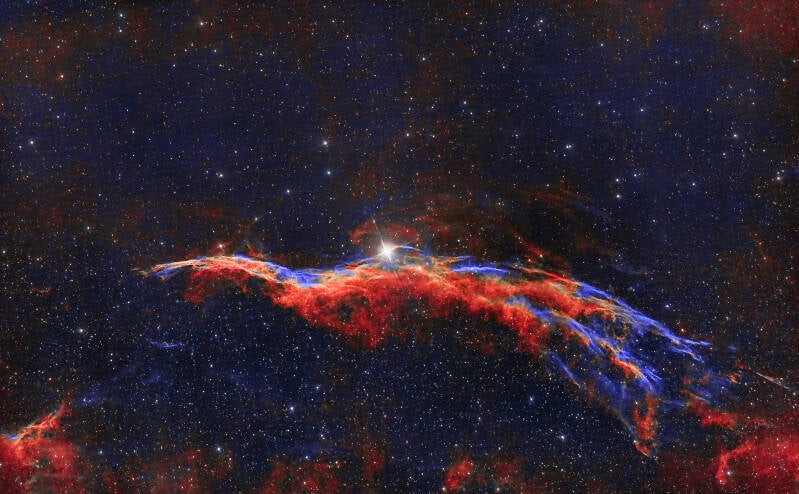First, the english version somewhere in between the german & then the slovene
Here I go... Again 😁.
After a good month since my Canon made the last click, I finally assembled and processed this nebula. In the meantime, I was a photographer at a wedding 😅🤭, also took photos of M27 (will need to process the data once too 🙄), attended two parties, one concert (Let3 ruuulz 🤘) and one star party under the full moon. Let not forget that my processing program was updated and then collapsed into oblivion 😅.
Well, let's get to the actual post 😎.
Before the vacation, I received a "request" from a colleague from the Črnomelj photo club to take some photos for her. So we decided on NGC 6960, also known as the Veil Nebula.
I spent the first night of photography in Dolenjska (thanks to Jože Repovž for allowing me to use the spot under the stars), I was accompanied by Gregor Hutar and his "machinery".
For the next two nights (of 14😕😒), I photographed on my vacation, on the island of Pag, not far from Novalja (almost full moon). I had company here too (thanks Peter Leskovar 😎💪). The weather itself was nothing special, I could even say that such a below average sky I have not seen for a long time. Let's move slowly towards the target itself and the equipment I used.
EQUIPMENT:
- skywatcher Heq5 pro on a steel tripod.
- Newton TS Optics 150/750mm (f5) telescope.
- Baader coma corrector MPCC mark 3 (used for the first time).
- capture camera: Canon Eos 500Da.
- Filter: Optolong L-Enhance.
- telescope for guidance: Generic 60/240mm (f4).
- camera for guidance: Player one Neptune C2.
- program for polar adjustment and image capture: N.i.n.a
- guiding program: PhD2.
Some more information about captured photos:
- 250x180 seconds of light frames.
- 30x180 seconds of dark frames.
- 100x 0.00025 second bias shots.
- for each night separately, I also recorded calibration shots (flat and dark flat frames), 25 shots per night.
The integration time is about 13 hours.
- everything is assembled and processed in the PixInsight program (I'm still learning 🤓).
Below are two photos of NGC 6960, processed differently.
I would also like to thank Mr. Luke Newbould (thx for all the youtube tutorials, you are the Best 😎💪🤞).
And a short description of the target (some dry data collected from the internet).
Clear skies!
Los geht's... Schon wieder 😁.
Gut einen Monat nachdem meine Canon den letzten Klick gemacht hat, habe ich diesen Nebel endlich zusammengebaut und bearbeitet. In der Zwischenzeit war ich Fotograf auf einer Hochzeit 😅🤭, habe auch Fotos von M27 gemacht (muss die Daten auch einmal verarbeiten 🙄), war auf zwei Partys, einem Konzert (Let3 ruuulz 🤘) und einer Sternenparty bei Vollmond . Vergessen wir nicht, dass mein Verarbeitungsprogramm aktualisiert wurde und dann in Vergessenheit geriet 😅.
Kommen wir nun zum eigentlichen Beitrag 😎.
Vor dem Urlaub erhielt ich eine „Anfrage“ von einer Kollegin des Fotoclubs Črnomelj, ein paar Fotos für sie zu machen. Also entschieden wir uns für NGC 6960, auch bekannt als Schleiernebel.
Die erste Nacht des Fotografierens verbrachte ich in Dolenjska (Danke an Jože Repovž für die Erlaubnis, den Platz unter den Sternen zu nutzen), ich wurde von Gregor Hutar und seiner „Maschinerie“ begleitet.
Die nächsten zwei Nächte (von 14😕😒) habe ich in meinem Urlaub fotografiert, auf der Insel Pag, unweit von Novalja (fast Vollmond). Auch hier hatte ich Gesellschaft (danke Peter Leskovar 😎💪). Das Wetter an sich war nichts Besonderes, ich könnte sogar sagen, dass ich schon lange nicht mehr einen so unterdurchschnittlichen Himmel gesehen habe. Gehen wir langsam auf das Ziel selbst und die von mir verwendete Ausrüstung zu.
AUSRÜSTUNG:
- skywatcher Heq5 pro auf einem Stahlstativ.
- Newton TS Optics 150/750 mm (f5) Teleskop.
- Baader Koma-Korrektor MPCC Mark 3 (erstmals verwendet).
- Aufnahmekamera: Canon Eos 500Da.
- Filter: Optolong L-Enhance.
- Teleskop zur Orientierung: Generisches 60/240 mm (f4).
- Kamera zur Orientierung: Spieler eins Neptune C2.
- Programm zur Polanpassung und Bilderfassung: N.i.n.a
- Leitprogramm: PhD2.
Noch ein paar Informationen zu aufgenommenen Fotos:
- 250x180 Sekunden Lichtbilder.
- 30x180 Sekunden dunkle Bilder.
- 100 x 0,00025 Sekunden Bias-Aufnahmen.
- Für jede Nacht einzeln habe ich außerdem Kalibrierungsaufnahmen (Flat- und Dark-Flat-Frames) gemacht, 25 Aufnahmen pro Nacht.
Die Integrationszeit beträgt etwa 13 Stunden.
- alles wird im PixInsight-Programm zusammengestellt und verarbeitet (ich lerne noch 🤓).
Unten sind zwei Fotos von NGC 6960, unterschiedlich bearbeitet.
Ich möchte auch Herrn Luke Newbould danken (Danke für all die YouTube-Tutorials, du bist der Beste 😎💪🤞).
Ewo mene... Spet 😁.
Po dobrem mesecu, kaj je moj Canon naredil zadnji klik, sem končno sestavil in obdelal tole meglico. Navmes sem bil Fotograf na poroki 🫣😅🤭, fotkal tudi M27 (bo treba tudi enkrat obdelat podatke 🙄), bil na dveh žurih, enem koncertu (Let3 ruuulz 🤘) in se enkrat podružil ob polni Luni. Da ne pozabim, da se mi je program za obdelavo updejtal in nato sesipal v prafaktorje 🤭😅.
No, gremo na dejansko objavo 😎.
Pred dopustom sem dobil "prošnjo" od kolegice iz Črnomaljskega foto kluba, da bi ji nekaj pofotkal. Pa sva (smo) se odločila za NGC 6960, poznano tudi kot meglica Tančica.
Prvo noč fotografiranja sem opravil kar na Dolenjskem (hvala za prostor Jože Repovž), družbo mi je delal Gregor Hutar s svojo "mašinerijo".
Nadaljne dve noči (od 14tih😕😒), sem fotografiral na dopustu, na otoku Pagu, nedaleč stran od Novalje (ob skoraj polni Luni) . Tudi tukaj sem imel družbo (hvala Peter Leskovar 😎💪). Samo vreme ni bilo nič posebnega, lahko bi celo rekel, da tako podpovprečnega neba že dolgo ni bilo. Pa pojdimo počasi proti sami tarči in opremi, ki sem jo uporabil.
OPREMA:
- montaža skywatcher Heq5 pro na jeklenem stativu.
- teleskop Newton TS Optics 150/750mm (f5).
- Baader koma korektor MPCC mark 3 (prvič uporabljen).
- kamera za zajem: Canon Eos 500Da.
- Filter: Optolong L-Enhance.
- teleskopek za vodenje: Generični 60/240mm (f4).
- kamera za vodenje: Player one Neptune C2.
- program za polarno nastavitev in zajem slik: N.i.n.a
- Program za vodenje: PhD2.
Še par podatkov o zajetih fotografijah:
- 250x180 sekund svetlobnih posnetkov (light frames).
- 30x180 sekund temnih posnetkov (dark frames).
- 100x 0.00025 sekund bias posnetkov.
- za vsako noč posebej pa sem posnel tudi kalibracijske izravnalne posnetke (flat in dark flat frames), po 25 posnetkov na noč.
Integracijski čas je približno 13 ur.
- vse skupaj je zloženo in obdelano v programu PixInsight (še vedno se učim 🤓).
Spodaj sta (so) dve fotografiji NGC 6960, različno obdelani.
Najlepše bi se zahvalil gospodu Luke Newbould - @Lukomatico; (thx for all the tutorials, you are the Best 😎💪🤞).
Pa še kratek opis tarče (neki suhoparni podatki pobrani iz internetof).
Meglica tančica je oblak segretega in ioniziranega plina in prahu v ozvezdju Laboda. Sestavlja vidne dele Labodove zanke, ostanka supernove, katere številni deli so pridobili svoja lastna imena in kataloške identifikatorje. Izvorna supernova je bila zvezda, ki je bila 20-krat masivnejša od Sonca in je eksplodirala pred 10.000 do 20.000 leti. V času eksplozije bi bila supernova videti svetlejša od Venere na nebu in vidna podnevi. Ostanki so se od takrat razširili in pokrivajo območje neba s premerom približno 3 stopinje (približno 6-kratni premer in 36-kratno območje polne Lune). Medtem ko so prejšnje ocene razdalje znašale od 1200 do 5800 svetlobnih let, nedavna določitev 2400 svetlobnih let temelji na neposrednih astrometričnih meritvah. (Ocene razdalje vplivajo tudi na ocene velikosti in starosti.) Vesoljski teleskop Hubble je posnel več slik meglice. Analiza emisij iz meglice kaže na prisotnost kisika, žvepla in vodika. Cygnus Loop je tudi močan oddajnik radijskih valov in rentgenskih žarkov. 24. septembra 2015 je Znanstveni inštitut za vesoljski teleskop objavil nove slike in video posnetke meglice Veil z razlago slik.
Jasnega neba!
P.S
Spodaj so različne obdelave (palete) istega objekta





Add comment
Comments